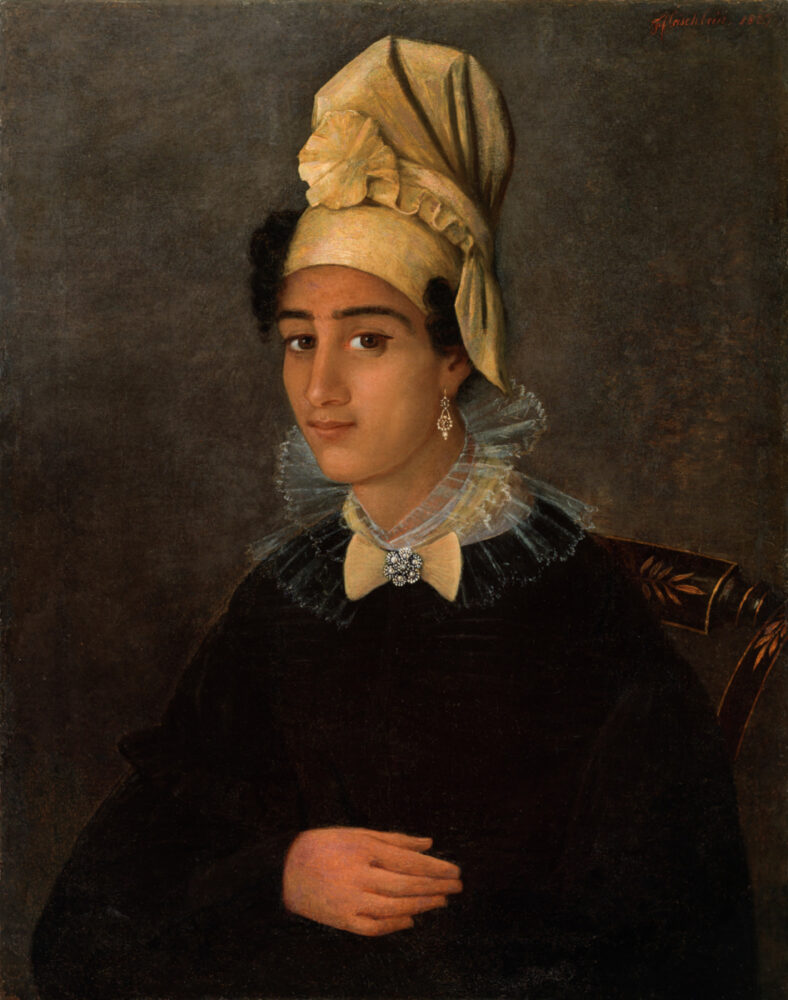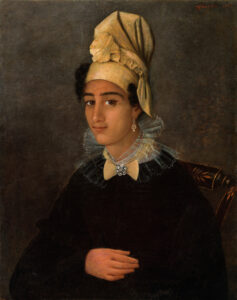Free People of Color from the Early American Period through the Civil War
After the Louisiana Purchase, lawmakers passed numerous restrictions against free people of color, though they still experienced some economic gains and opportunities.
This entry is 7th Grade level View Full Entry

The Historic New Orleans Collection.
Portrait of a Free Woman of Color by François Jacques Fleischbein.
How did American rule affect free people of color in Louisiana, and how did they respond?
When American officials arrived in New Orleans in 1803, they found a sizable French-speaking free Black community with rights and customs uncommon in other parts of the United States. Many Anglo-Americans viewed free people of color with suspicion, especially companies of armed militiamen. They feared the possibility of enslaved and free people of African descent joining together in rebellion, like in the Haitian Revolution.
In 1806 and 1808 white lawmakers passed the first of numerous legal restrictions enacted against free people of color under American rule. These laws made manumission more difficult; attempted to stop free Black people from moving to Louisiana; ended the free Black militia; limited how much the children of unmarried parents could inherit; and required the description “free man/woman of color” be included in all official documents.
From 1809 to 1810 more than 10,000 refugees from Saint-Domingue (now Haiti) relocated to New Orleans from Cuba, doubling the city’s total population. Approximately 3,000 free Black Saint-Dominguans, mostly women and children, tripled the free people of color population. In 1810 New Orleans was home to almost 5,000 free people of color, making up close to 29 percent of the city’s total population, a far higher proportion than any other city in the American South.
In 1811 enslaved plantation workers led the German Coast insurrection, and the free Black militia was brought back the very next year. During the War of 1812, free men of color were called upon to defend New Orleans against the British. Two free Black battalions, which included 353 New Orleanians and 256 Saint-Dominguans, fought for the United States in the 1815 Battle of New Orleans.
In the years after the Battle of New Orleans, Louisiana experienced tremendous economic growth, supported by the expansion of slavery. This rapid economic development during the first half of the nineteenth century provided free people of color opportunities to increase their wealth. Most individuals owned small amounts of property, but some became quite wealthy. In 1861 merchant tailor François Lacroix had a real estate portfolio worth more than $200,000 (more than $6 million in 2022). Andrew Durnford enslaved seventy men, women, and children on a large plantation in Plaquemines Parish valued at $161,000 in 1850 (about $5 million in 2022).
The term “free person of color” was a legal category. The individuals to whom this label was applied were actually quite diverse. Free people of color in Louisiana could be African-born or born in the Americas. They could be formerly enslaved or born free. They may have been of only African ancestry or of mixed racial ancestry—African, European, and/or Native American. Most of Louisiana’s free people of color were French-speaking, and many of them referred to themselves as Creoles. A smaller proportion of free people of color spoke English as their first language; they were often referred to as “Americans” and likely came to Louisiana from another state.
Laws governing the rights and behaviors of free people of color varied over time, becoming more restrictive during the nineteenth century. As the number of free people of color in Louisiana continued to grow, reaching its peak in 1840, local and state lawmakers passed additional measures to limit the population and create more racial boundaries.
Faced with increasing discrimination, free people of color began to develop their own institutions in the 1830s and 1840s. In New Orleans French-speaking free people of color created religious organizations, literary societies, and schools. Henriette Delille founded the Sisters of the Holy Family, a Catholic order of nuns, between 1836 and 1852. Free men of color formed mutual aid societies, including the Société des Artisans (1834) and the Société d’Economie (1836). In 1847 a group of men led by François Lacroix founded a school for children called L’Institution Catholique des Orphelins Indigents (Catholic Institution for Indigent Orphans). With their family connections and social networks, these collective institutions further strengthened associations among French-speaking free people of color.
The nineteenth century also saw the development of an English-speaking population of free people of color in New Orleans, consisting of formerly enslaved people who arrived through the domestic slave trade as well as free Black migrants. These men and women also created institutions, including Protestant churches and Masonic lodges. They remained mostly separate from the larger French-speaking, Catholic free Black community.
Outside of New Orleans, St. Landry and Natchitoches Parish had the largest numbers of free people of color. Rural free Black populations originated in the Spanish period. Their descendants usually married other free people of color, forming extended family units that owned farms and plantations. The Isle Brevelle community in Natchitoches is one notable example. Founded by the children of Marie Thérèse CoinCoin and Frenchman Claude Pierre Metoyer, Isle Brevelle contained eighty-nine families in 1860. They owned thousands of acres and hundreds of enslaved people. Rural free people of color also built their own spaces of worship and education. Augustin Metoyer, the son of CoinCoin and Metoyer, erected a Catholic church in Isle Brevelle in 1829. Free children of color in St. Landry Parish attended the Grimble Bell School.
By the mid-nineteenth century, the state had the largest number of free Black people in the Deep South as well as some of the wealthiest. In the decade before the Civil War, free Louisianans of color experienced repressive laws, racially motivated violence, and vilification by the media. In the southwestern parishes, white vigilante groups shut down the Grimble Bell School and used violence to force free Black residents to leave. In addition to laws that restricted their rights, free men and women of African descent in New Orleans faced competition in the labor market from the influx of European immigrants to the city. Some families left Louisiana for better treatment and opportunities in places like Mexico, Haiti, and France. Others stayed in Louisiana and participated in the Civil War. Free men of color served as officers and soldiers in the Union Army. In New Orleans they started newspapers and political organizations to fight for equal rights for Black people.
